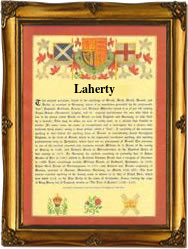This notable surname, chiefly found in the Province of Ulster, is an Anglicized form of the Gaelic "O'(Fh)laithbheartaigh" or "MacFhlaithbheartaigh". Traditionally, Irish family names are taken from the heads of tribes, or some illustrious warrior, and are usually prefixed by "O", grandson, male descendant of, or "mac", son of. In this instance, the personal name "Flaighbheartach" is composed of the elements "flaith", prince, ruler, and "beartach", doer of valiant deeds, which points to the noble origins of the clan. The Chief of the Laverty sept was Lord of Aileach (modern Elagh, Co. Donegal), and he is described in the Annals of the Four Masters as the "Tanist of Tyrone", the term "tanist" meaning "the heir apparent of a Celtic chieftain, chosen by election during the Chief's lifetime: usually the worthiest of his kin". The ultimate origin of the word is the Gaelic (Irish) "tainiste", literally, "the second person". The modernized Gaelic spelling of the name, O'Laifeartaigh, gives rise to further Anglicized forms, such as Lafferty and Laherty. On January 27th 1744, John Laverty and Mary Currie were married in Belfast, Co. Antrim. Medina Laverty, aged 13 yrs., who embarked from Londonderry on the ship "Mary Harrington" bound for New York on June 2nd 1846, was a famine emigrant to that city. The first recorded spelling of the family name is shown to be that of O'Laherty, which was dated circa 1560, in the Elizabethian "Fiant Litterae Patentes", during the reign of Queen Elizabeth 1 of England, known as "Good Queen Bess", 1558 - 1603. Surnames became necessary when governments introduced personal taxation. In England this was known as Poll Tax. Throughout the centuries, surnames in every country have continued to "develop" often leading to astonishing variants of the original spelling.
© Copyright: Name Origin Research 1980 - 2024

Enjoy this name printed onto our colourful scroll, printed in Olde English script. An ideal gift.
